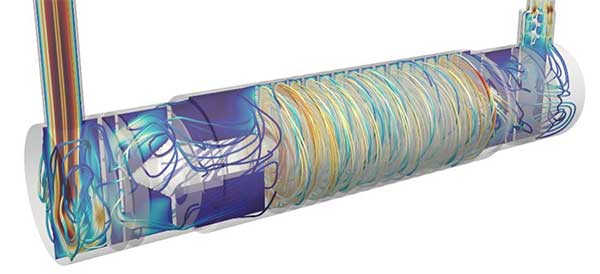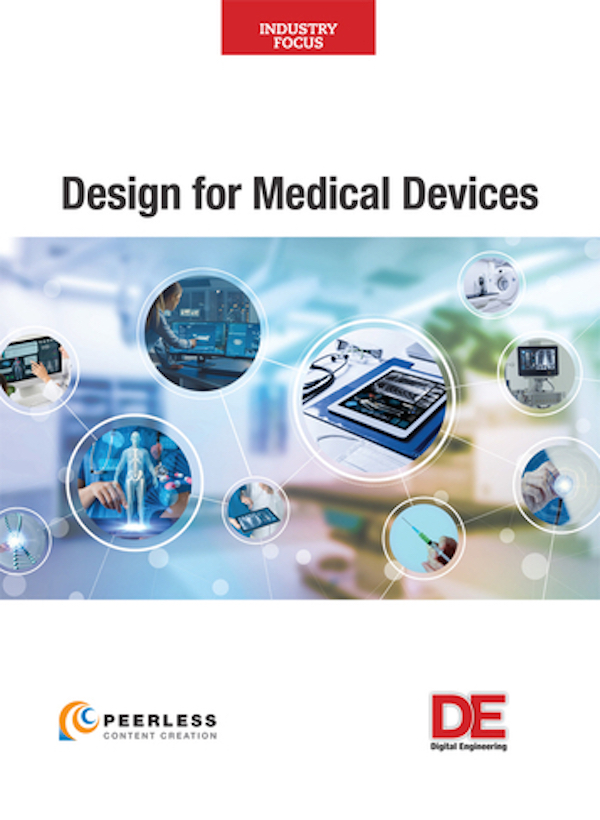
Airflow simulation in a UV sterilization chamber of an iPAP ventilator for COVID-19 patients. Image courtesy of OnScale/Lexma.
Latest News
June 9, 2020
OnScale and Lexma are jointly unveiling Lattice-Boltzmann Method (LBM) Computational Fluid Dynamics (CFD) solver for advanced fluid dynamics simulations on the OnScale Cloud Engineering Simulation platform.
“Moebius represents a step-change in CFD speed, power, and democratization for digital prototyping of devices involving fluid flows,” says David Freed, CTO of OnScale and a digital physicist with a 25-year track record of advancing LBM CFD technology at MIT, Exa Corporation and Dassault Systѐmes. “Moebius running on the massively scalable OnScale Cloud Engineering Simulation platform will break barriers to innovation for a variety of applications such as lab-on-a-chip, MEMS and medical diagnostic and treatment devices like next-generation ventilators and respirators.”
LBM takes a kinetic theory approach to simulating fluid flows, which enables the simulation of complex biomedical and engineering problems, including multiphase flows, particle transport, and fluid-structure interaction. The resulting simulations provide insight and design guidance for engineers advancing new technologies.
“Integrating Moebius with the OnScale Cloud Engineering Simulation platform allows our team to focus on our mission—creating the world’s best LBM CFD solutions—while leveraging OnScale’s cloud supercomputer scalability and SimAPI for CAD import, model setup, data management, and viewing simulation results,” says Franck Pérot, CEO of Lexma Technologies. “We also get OnScale’s account management, billing, customer support, and marketing and sales automation features built in.”
“With Moebius running on OnScale, we were able to optimize the design of our Intelligent Positive Air Pressure (iPAP) machine with UV disinfecting chamber,” says Shashi Buluswar, CEO of the Institute for Transformative Technology (ITT). “Using OnScale and Moebius to create Digital Prototypes of our device dramatically shortened our physical prototyping cost and time and allowed us to accelerate our goal of delivering critical iPAP devices to low-income countries to save lives during the COVID-19 pandemic.”
A critical design and engineering aspect of the iPAP device is the UV disinfecting chamber, which is intended to disinfect up to 99.9% of the air exhaled from a COVID-19 patient’s lungs. The ITT team needed to minimize size, cost, and heat generated by the chamber while maximizing the amount of time air spends in it. The team used Moebius running on OnScale to simulate many “Digital Prototypes” of the disinfecting chamber and process until converging on a manufacturable design.
A design and engineering aspect of the iPAP device is the UV disinfecting chamber, which is intended to disinfect up to 99.9% of the air exhaled from a COVID-19 patient’s lungs. The ITT team needed to minimize size, cost, and heat generated by the chamber while maximizing the amount of time air spends in it. The team used Moebius running on OnScale to simulate many “Digital Prototypes” of the disinfecting chamber and process until converging on a manufacturable design.
Sources: Press materials received from the company and additional information gleaned from the company’s website.
More OnScale Coverage

Subscribe to our FREE magazine, FREE email newsletters or both!
Latest News
About the Author
DE’s editors contribute news and new product announcements to Digital Engineering.
Press releases may be sent to them via [email protected].
Related Topics







